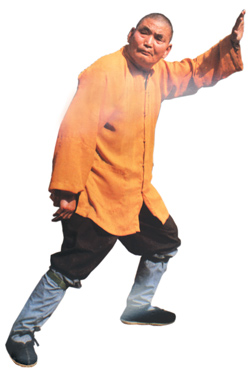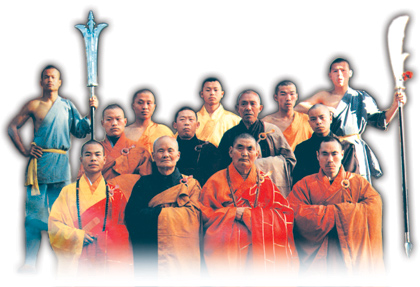Shaolin's Senior Grandmaster Venerable Shi Suxi
By Gene Ching
 Every Shaolin monk has a special generation name. There are Heng's (as in Shi Hengxin,) Yan's (as in Shi Yanming and Shi Yansi a.k.a Shi Guolin) and Yong's (as in Venerable Abbot Shi Yongxin.) These are 35th, 34th and 33rd generations, respectively. Then there are the Xing's (as in Shi Xinghao and Shi Xingying) who are 32nd generation and the De's (as in Shi Decheng and Shi Deshan) who are 31st generation. Then there are the Su's, the eldest living generation of Shaolin monks today.
Every Shaolin monk has a special generation name. There are Heng's (as in Shi Hengxin,) Yan's (as in Shi Yanming and Shi Yansi a.k.a Shi Guolin) and Yong's (as in Venerable Abbot Shi Yongxin.) These are 35th, 34th and 33rd generations, respectively. Then there are the Xing's (as in Shi Xinghao and Shi Xingying) who are 32nd generation and the De's (as in Shi Decheng and Shi Deshan) who are 31st generation. Then there are the Su's, the eldest living generation of Shaolin monks today.
There are only a few remaining monks and disciples that bear the name Su now. Most prominent is Venerable Shi Suxi, one of Shaolin's eldest and most respected monks. Su means he is of the 30th generation. Xi means "happy" or "joy." Just like Muhammad Ali, Suxi suffers from Parkinson's disease and is now wheelchair bound. Nevertheless, his mind is still quick as lightning and his heart is still generous as ever. And his eyes still glow, reflecting the fires he witnessed from over six decades of living at Shaolin Temple.
A Boy Praying to Buddha
Suxi was born into a life of extreme poverty in nearby Dengfeng city in 1926. His birth name was Geng Shuanzhu. He entered monastic life at 13 because his family was so poor that it was his only way to survive. That was a little more than a decade after the tragic attack on Shaolin Temple by warlord Shi Yousan. The temple burned for 40 days, reducing ninety percent of its precious holdings to ash. Suxi says that when he arrived, the temple was still "worn out, a shabby ruin." He recalls only about 100 small buildings still stood in the area including Erzuyuan (Second ancestor ?Huike's' hall) and Fo Zhuyuan (Buddha hall.) Around hundred monks remained. Visitors were very scarce and communication back then was not at all convenient. Even in Shaolin's home province of Henan, few remembered where the Temple was.
When Suxi first entered Shaolin, he worked the lowly jobs like the small cleaning duties. But he toiled very hard, strictly obeyed the rules, and showed great respect to his teachers and elders, so he excelled quickly, soon catching the attention of other monks. Shaolin Temple's head monk at that time, Zhen Xu (1893-1955) gave Suxi his Shaolin Buddhist name and sent him up to Shaolin's Xuetang (study hall) to train in the ways of Shaolin. Everyday, Suxi studied kungfu early in the morning and late into the night. Soon his extraordinary kungfu skill became clear to all. He was unlike the others. They said his posture was simple like iron, not fluffy. He was soft as a silk thread, fierce as a tiger snatching a lamb and vital as a monkey springing over a wall. When he walked, it was like a black dragon crossing the sea. But most important, he was renown for his great wude (martial ethics.) His filial piety was so devout that he posted his master's words by his bedside so he could study them every day.
- "To learn martial arts, you must learn to take a beating.
Smile against adversaries trying to press you.
A good teacher will promote wude.
Eating bitter and persistence will make a good martial artist."
Even though he was a Shaolin monk, Suxi did not limit himself to traditional Shaolin kungfu. His passion for the arts was compared to an unquenchable thirst, so he also observed all other kinds of martial arts. To Suxi, all martial art styles were part of one big family. A teacher and student learn from each other, whoever has the better skill becomes the teacher. In his eyes, all martial artists are equal.
A Warrior Monk Pounding a Pestle
By the late 60's, only twelve monks remained at Shaolin. When the Cultural Revolution struck, most of the monks were sent back to their native lands. Only one, after becoming a monk, never returned. Suxi remembers that dark period, but doesn't care to speak of it. He does say that he wasn't fearful during that time and that some clay statues and buildings were destroyed out of policy. But he adopts a Buddhist perspective on the matter. It was destroyed then and now it is repaired.
However it wasn't repaired right away. In 1981, Shaolin Temple was still in poor shape with very few monks still there. That December was uncommonly cold and Suxi was taken ill. Despite the foul weather, some visitors had made the trek all out to the temple in search of the real Shaolin kungfu. Since visitors were rare, Suxi ignored his sickness, faced the cold snow, and gave a powerful demonstration. Even when sick, he would still teach. Suxi showed them that Shaolin kungfu had indeed survived.
In the early 80's, Jet Li came to Shaolin Temple to make his debut film, Shaolin Temple. Before the movie, few remembered Shaolin. After the film hit it big, tourists were flocking to visit Shaolin. The movie benefited Shaolin Temple enormously by bringing it back into popularity. Tourism transformed the lonely solemn temple dramatically and not all of it was positive. The tourist economy brought both restoration and blatant tourist traps. Today, there still stands a roller coaster simulator just down the street from the temple. But Suxi remembers Shaolin's darker years and rejoices at this latest turn of Karma. To him, tourism doesn't matter. He hopes that more people, both Chinese and non-Chinese, can learn Shaolin's legendary arts and make Chan Buddhism and Shaolin Kungfu more popular throughout the world.

A Warrior Monk Thinking of Buddha
What has molded Suxi's legacy has been his generosity. Perhaps it was his poor roots, or perhaps it was his thanks after collecting from the Shaolin donation boxes for so many years. There are countless stories of him rescuing runaway children and helping poor travelers to get home. In 1986, when the Henan Buddhism Society was on the verge of bankruptcy, Suxi donated his savings to keep it going. In the late 80's, when the Song Shan Shaolin Temple Wushuguan (Song Mountain Shaolin Temple Martial Arts Hall), China's largest facility solely devoted to teaching kungfu, was established west of the Temple, Suxi and his students Dewen and Deqian donated heavily. He saved all the money he earned and donated to China's building restoration programs.
Suxi's charitable heart even tames wild beasts. Suxi once met a famous tracker who was renowned for capturing wild tigers and relocating them to safer habitats. One of his recently captured tigers remained strangely calm when Suxi approached. The ferocious animal even let Suxi enter his pen and sit beside him. But Suxi never lets these incidents inflate his ego. When asked if he was afraid of the tiger, he retorts quickly "Of course!"
Deqian, Shaolin's most prolific author and researcher, worked intimately with his master to bring Shaolin to light. According to Deqian, they researched fighting for 100 days, neglected eating and sleeping, to develop the complete Shaolin system book, Shaolin Quan Shu Mi Zhuan. This book is still well loved by Chinese martial arts aficionados (it has yet to be translated.) The first printing was 90,000; the second was 560,000. Beyond Deqian, Suxi has over 3000 recognized students and has produced over 200 high level masters, including Deyang, Deren, and Deru (better known in America as Shawn Liu.)
For twelve years, Shaolin Temple was without an Abbot. Venerable Shi Xingzhen passed on in 1987 and the current Abbot, Venerable Shi Yongxin, was not inaugurated until 1999. During that period, Shaolin village underwent gross expansion, much of it due to the erection of the Song Shan Shaolin Si Wushuguan. Suxi had worked at the Abbot's room for more the 10 years. In 1992, Suxi was elected as the Shaolin Temple Mingzhuguan Weihui Juren. At a time when there was no ordained Abbot, so this was an equivalent position that put Suxi in charge of the entire area of Song Shan. This caused some confusion outside of Shaolin, since many did not distinguish between this political post and actual abbacy. Those who believed that Suxi was indeed abbot were very perplexed with Yongxin's actual ascension to abbacy. There was a remark floating around that Suxi ruled the north and Yongxin ruled the south, since they resided in the northern and southern part of the temple respectively. In truth, Yongxin is the real Abbot of Shaolin Temple. Suxi still resides in the north part of Shaolin Temple under Yongxin's abbacy. And that remark about Suxi's northern rule maybe particularly ironic given what may lie ahead for Suxi.
An Old Monk Lifting the Shoe
Poem by Shi Deqian
|
Even in his autumn years, the road ahead for Suxi is filled with promise. It is rumored that Shi Suxi has been offered the position of Abbot at the Southern Shaolin Temple in Fujian. The ruins of the original Southern Shaolin Temple are now deep in a downtown area, so the newly reconstructed temple was built atop nearby Putian Shan. The area is not nearly as developed as Song Shan and few foreigners have visited it. If Suxi accepts the position, not only will this be highly significant for both Shaolin Temples, it will be the first time Suxi has ever lived away from Song Shan.
Wherever Shi Suxi is bound, his timeless teachings will always be treasured. He had a specific message for readers of Kungfu Qigong. "Chan - the cradle of Chan, passed from Bodhidharma after nine years of meditation. Now, not many practice Chan to keep peace. Practitioners should bring peace to light. For the future of our cradle, masters must practice diligently the martial arts. Practice with heart and mind. Heart and mind are one. I hope more foreigners can learn our legendary arts and make Shaolin kungfu and Chan more popular throughout the world. I hope all human beings who love peace and our traditional culture heritage, both of China and the world, exchange skills and experience each other. I hope we all support each other and help each other. Buddha bless you."
Click here for Feature Articles from this issue and others published in
2002 .
Written by Gene Ching for KUNGFUMAGAZINE.COM
![]() Print Friendly Version of This Article
Print Friendly Version of This Article
















